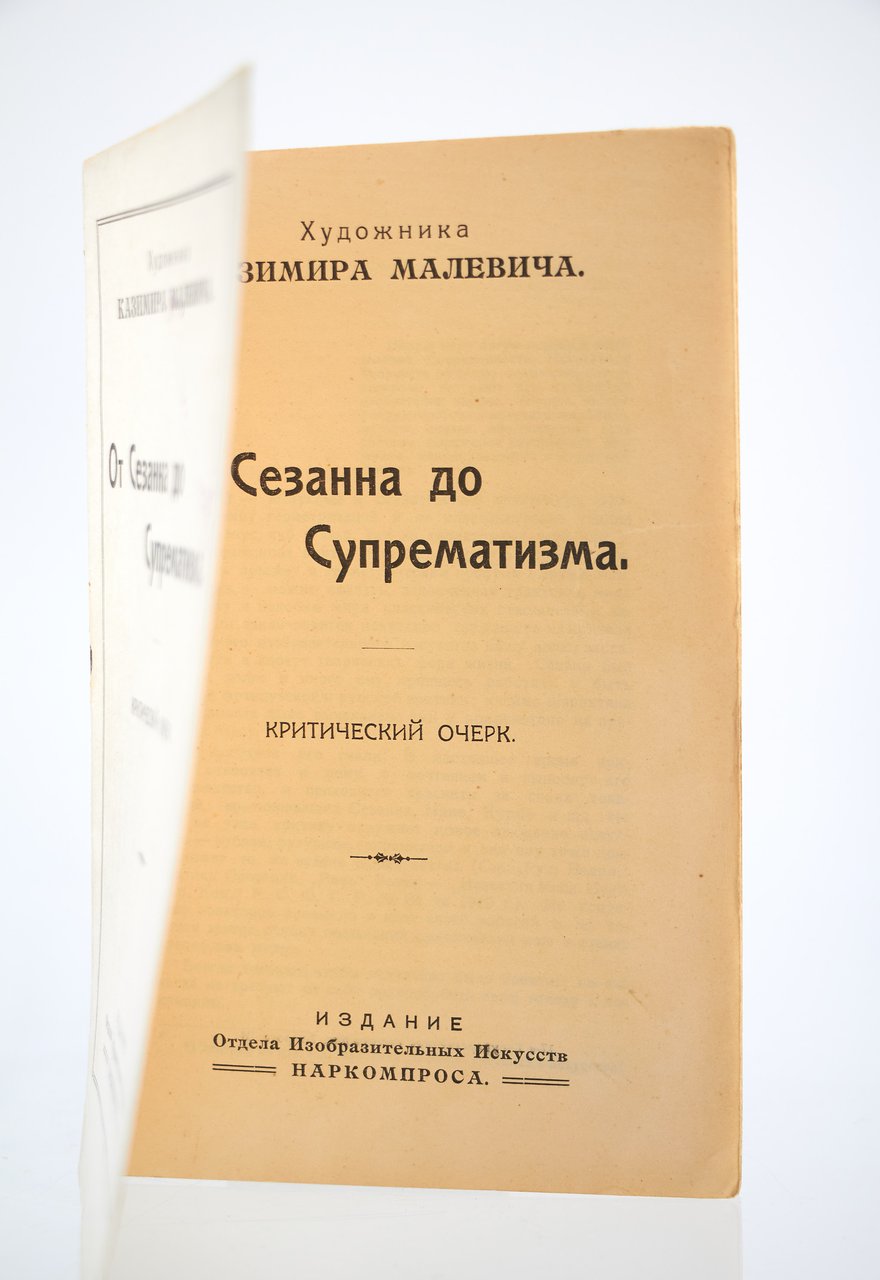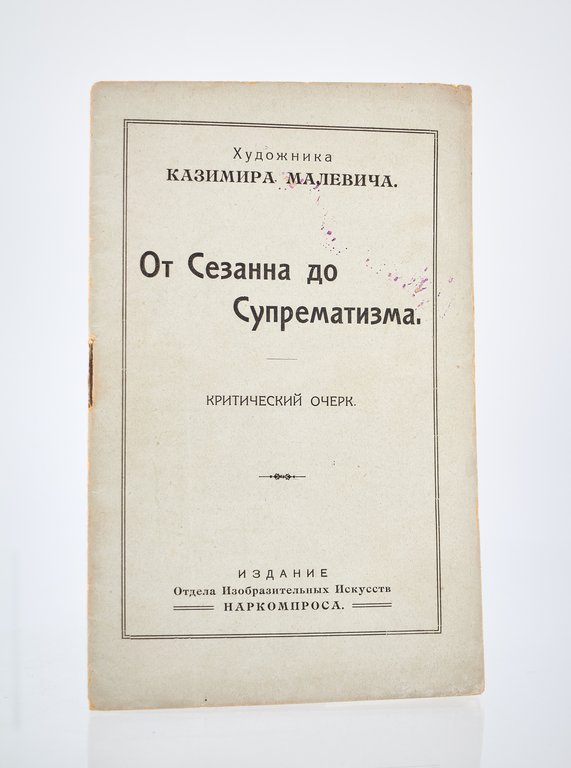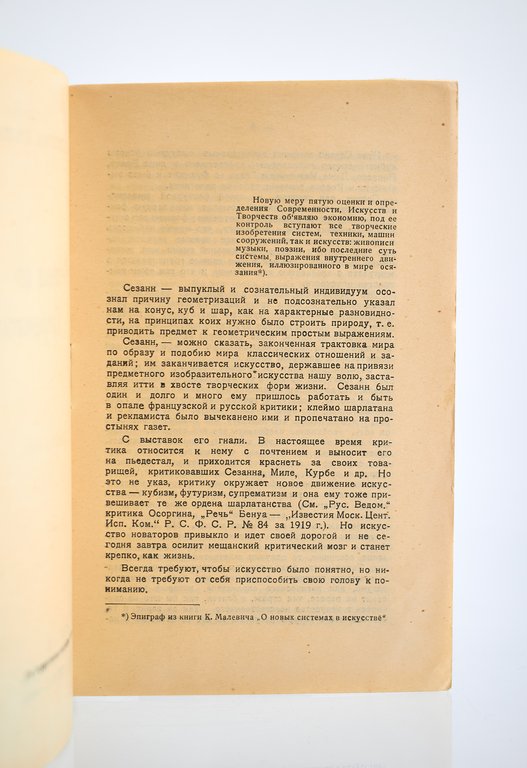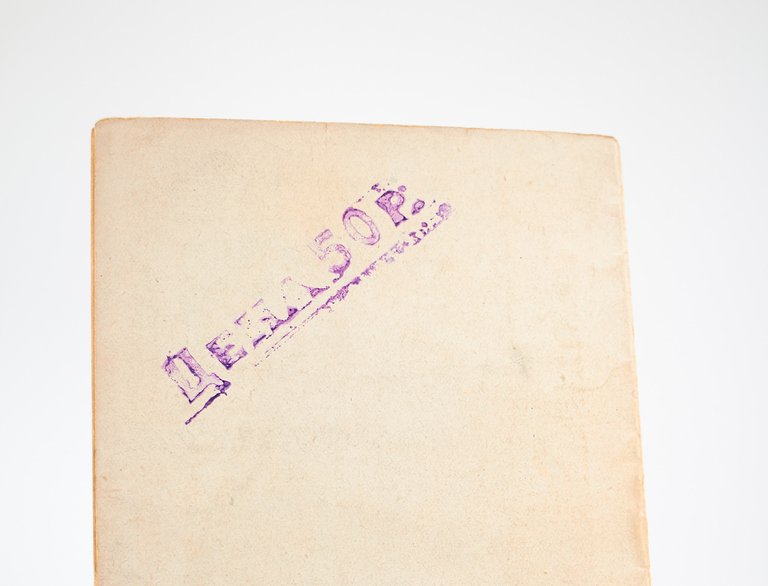- Izdanie Otdela Izobrazitel'nikh Iskysstv [Éditions du département d'art visuel] Narkompros [Commissariat du peuple à l'Éducation], s.l. [Petrograd] s.d (1920), 17,5x11,5cm, agrafé, 16p. - Ot Sezanna do Suprematizma Kriticheskii otcherk [From Cézanne to Suprematism. A critical essay] Izdanie Otdela Izobrazitel'nikh Iskysstv [Publishing house of the department of visual arts] | Narkompros [people's commissariat for education] | [Petrograd 1920] | 17.5 x 11.5 cm | stapled Extremely rare first edition. Small split at the foot of the spine, purple stamp with the price on the second board and a small mark on the first board of the stamp of another copy. A very beautiful copy. Published two years after his masterpiece White on White, this manifesto composed from his previous theoretical treatise On new systems on Art in 1919 is one of Malevitch's major writings. Written at the height of his artistic research, this summary of Malevitch's creative thought lays the theoretical foundations of Suprematism, understood not as a break with the past but, on the contrary, as the result of a history of Art freed from the "illusions of the sensitive world". Thus, Malevitch establishes an intellectual genealogy taking its roots in the work of Cézanne, Van Gogh and Monet, crossing Cubism and Futurism to result in Suprematism, this "statement of the total sovereignty of painting as it is , of the triumph of colour which in its very materiality, in its resonances, its intrinsic energy, discloses the abyssal reality in which objects merge until they disappear." (Jean-Claude Marcadé, postscript in De Cézanne au suprématisme, 1993). Known for his pictorial work, Malevitch was also a genius theorist. However, unlike others, his artistic reflection does not precede his work, it accomplishes it. He also abandoned creation between 1919 and 1920 to devote himself to this theoretical work, which would remain abstruse for many of his contemporaries. The Marxist journal Petchat' i révolyoutsiya will view From Cézanne to Suprematism only as "a collection of inept sentences". However, it is correct that this short treatise, enhancing Suprematist ambition, contains noticeable omissions, perhaps attributable to official censorship. But these reservations could also be down to Malevitch himself. Indeed, published by the "Commissariat du peuple à l'Éducation", directed by his friend and great defender of the arts, Anatoli Lounatcharski, this booklet is much more than a simple summary of Malevitch's theoretical work. As Jean-Claude Marcadé highlights, this "brochure printed in Moscow was destined to have greater distribution in artistic circles than [.] the small artisan copies of the Ecole de Vitebsk where Malevitch tried to impose his aesthetics, his pedagogy and his methodology under the label of the Affirmation du Nouveau Art (OUNOVIS). His fundamental dispute with official materialism, and especially figurative art, gives way [here] to an analysis of the origins of total non-figurative art (Cézanne, Cubism, Futurism) which aims to demonstrate to the adversaries of abstract art, the seriousness, the scientific character, the unwavering logic and the legitimacy [.] of the evolution of the visual arts. [.] From Cézanne to Suprematism is less an offensive work than a demonstration of the inevitable character of the Suprematist "deduction". The brevity of this booklet thus contributes to raising it to the rank of Manifesto, in the service of a revolutionary desire for collective metamorphosis of "human demonstrations". This auctorial intention is served by the reduced size of the volume and the Suprematist composition of the white cover with the eloquent title printed in quincunx, which poses Russian modernity as heir to the European pictorial revolution and white as a "deduction" from colour. This title summarising Malevitch's thinking will, precisely, be chosen by his biographers for the complete publication of his writings in 1993. Extremely rare and i




Découvrez comment utiliser
Découvrez comment utiliser
